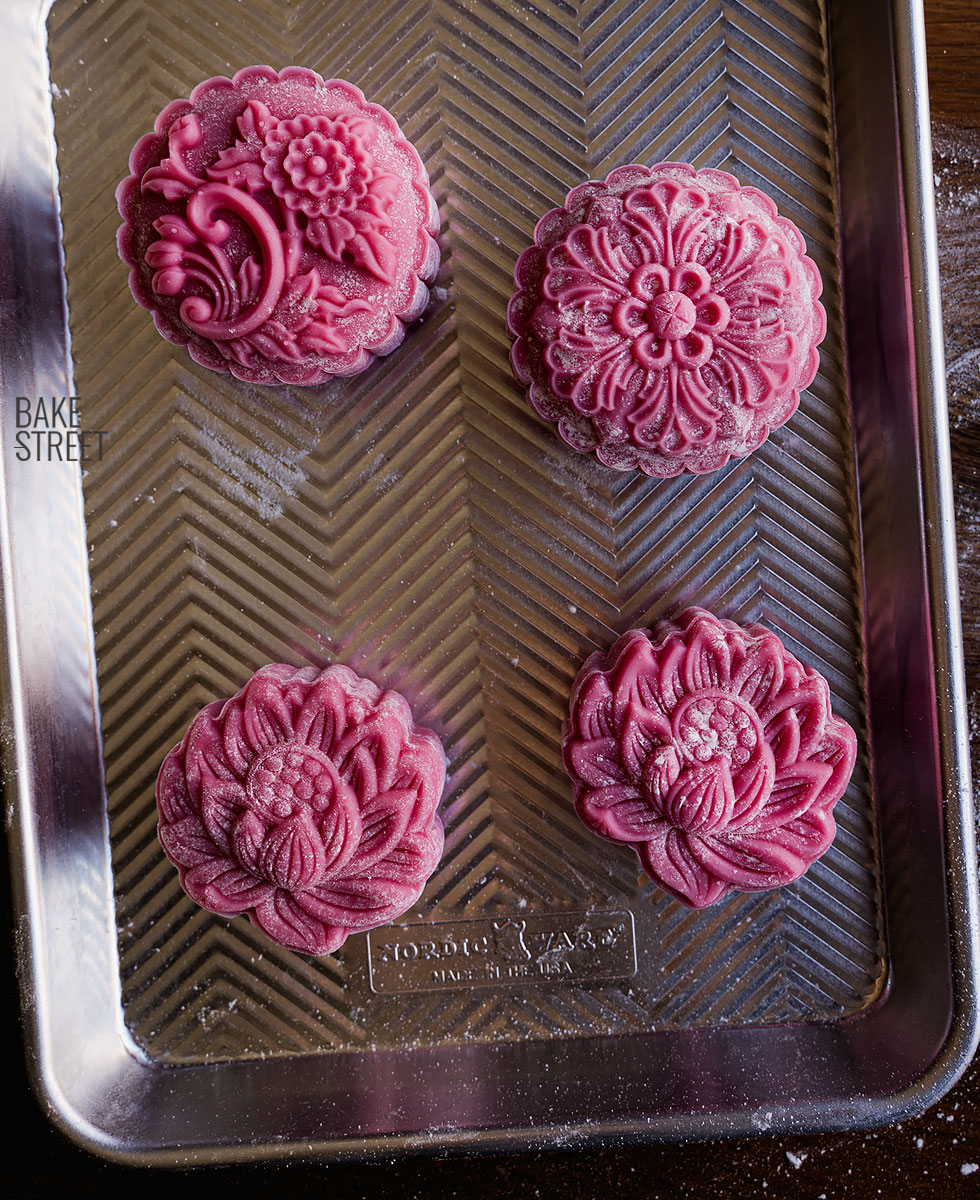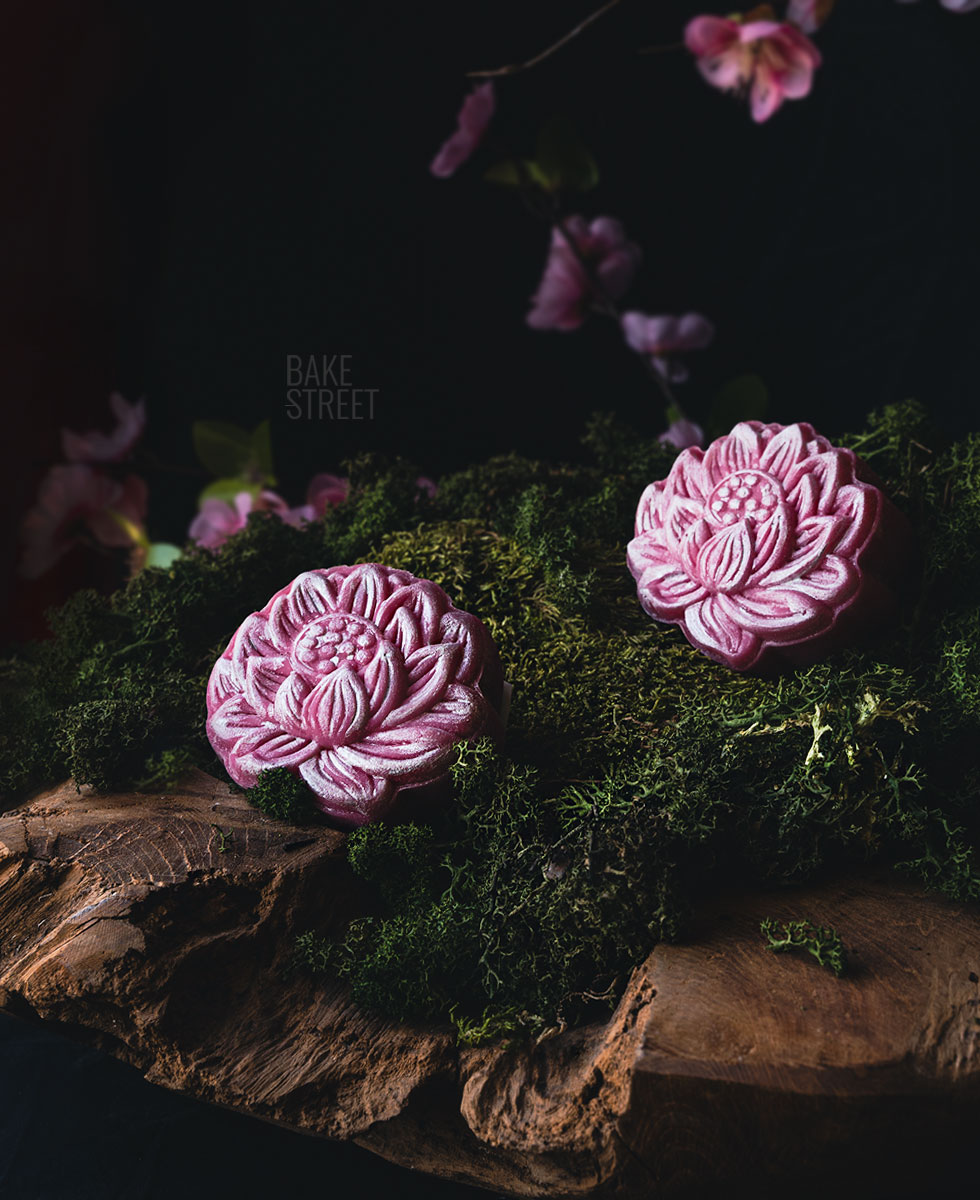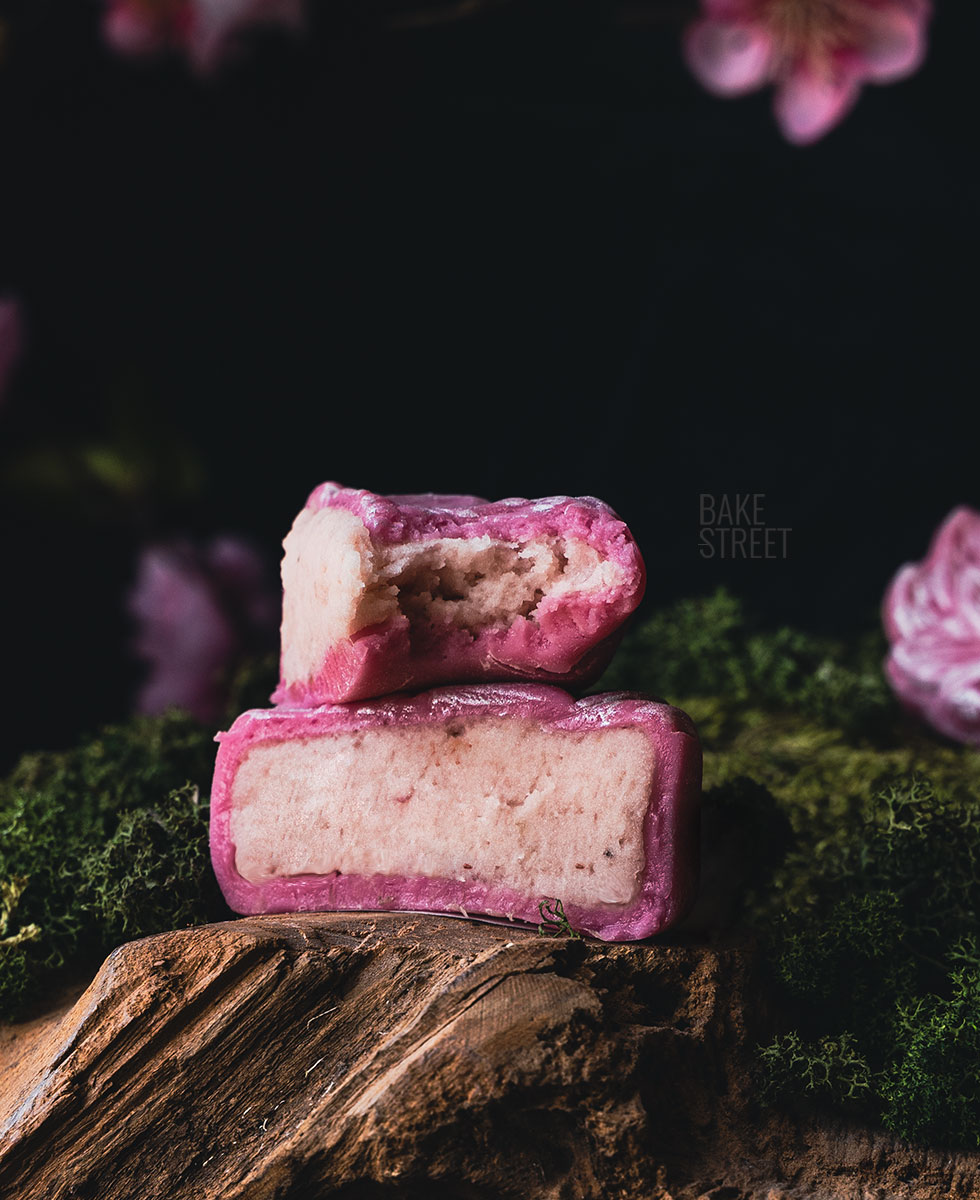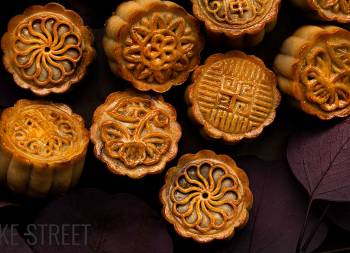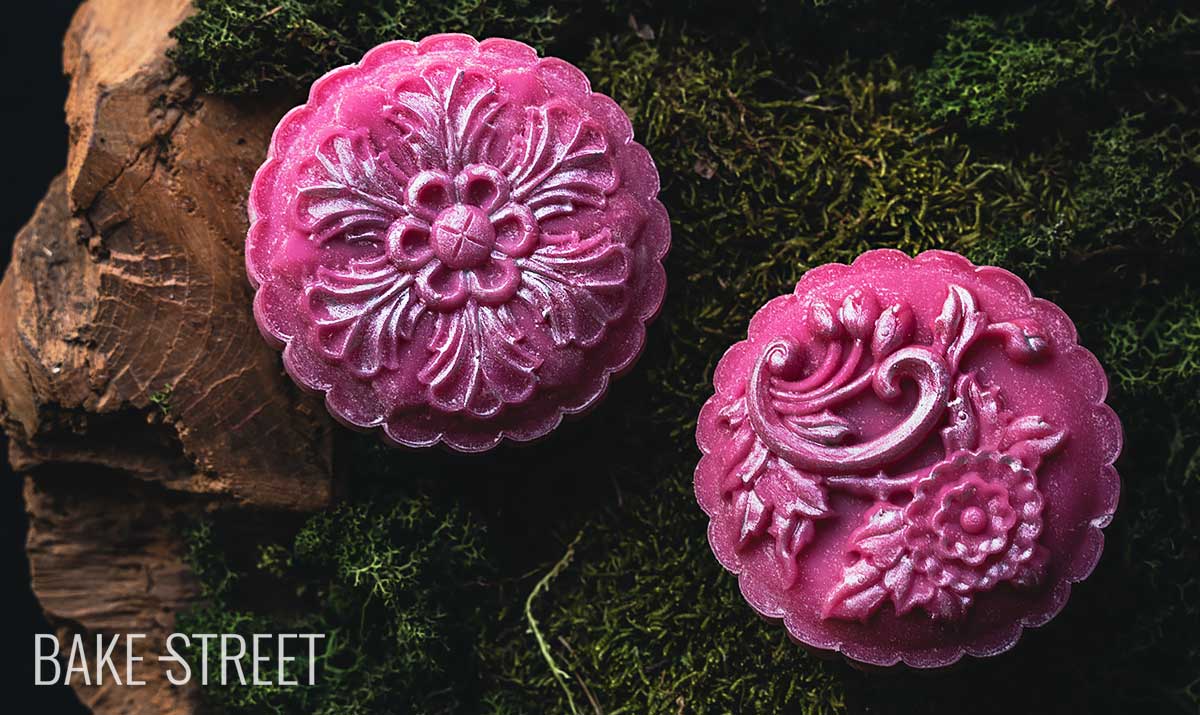
Sakura An Snow Skin Mooncakes
As every year, coming this time, I like to leave you recipes related to the Chinese Mid-Autumn Festival. On this occasion I leave you a mooncake recipe a little simpler than the traditional one, and very surprising, by the way. Snow Skin Mooncakes with Sakura An.
I’ve been wanting to make them since last year, but I decided to wait until these dates to prepare and share them with you. Besides, this way I had a good excuse to buy more mooncake molds, I love them! Every year I buy a few new ones. This year, I think it has been the year that I have bought more molds at once …. Two of them I show you in today’s recipe and, I hope, I can show you the rest soon.
Giving a twist to tradition.
The original or traditional mooncakes are made with a very thin dough that, after covering the filling with it and shaping it with the mold, is baked. On my website you can find some filled with anko and another ones filled with lotus paste and salted egg yolk. In both cases I show you how to make the homemade fillings. I can tell you that the final result has nothing to do with these store-bought pastries.
This year I wanted to leave you with an option that, I think, you will like very much. They are mooncakes that do not need baking in the oven since the top cover is made with a dough made with glutinous rice that is very reminiscent of mochis. The filling I used is the pickled cherry blossom bean paste that I left you a few days ago, Sakura An. Of course, as you may already guess, these mooncakes can be filled with whatever you like. As long as the fillings are suitable for this type of cake, we cannot use fillings that are too moist or that do not keep their shape.
Red bean paste, anko or lotus paste, Lian rong, could be used without any problem.
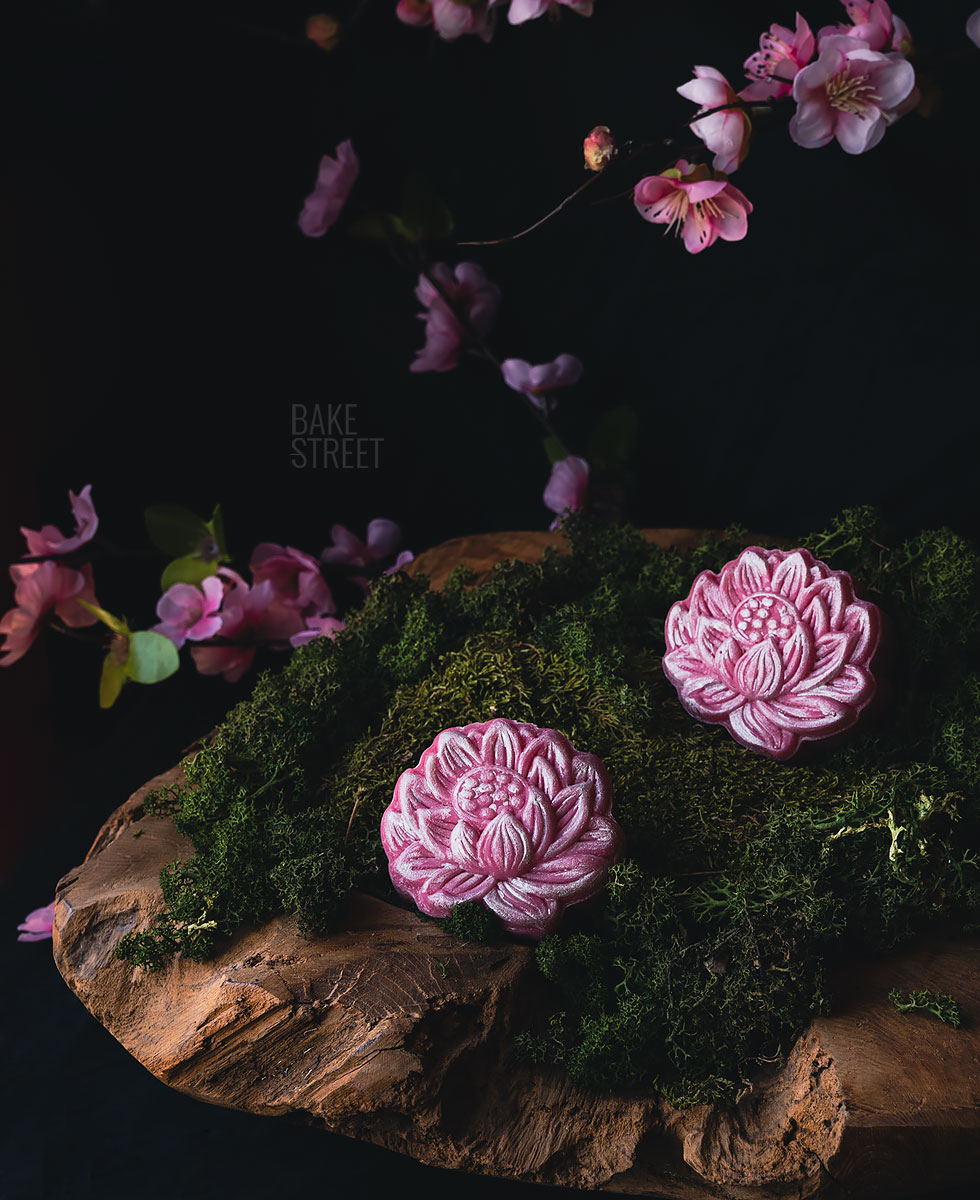
Snow Skin Mooncake origin.
Mooncake is one of the most appreciated traditional cakes in East and Southeast Asia, as it is synonymous with the Chinese Mid-Autumn Festival. It is a festival that coincides with the full moon, that is, the fifteenth day of the eighth lunar month.
If you want to know all its history, origin, legends and traditions, I tell you everything in this post.
Mooncakes have been an essential part of Chinese culture for centuries, especially during the Mid-Autumn Festival. Among the many varieties of mooncakes we can find, the snow skin mooncake stands out for the tender and delicate texture of its topping. The particularity of this cake lies in the fact that, unlike the traditional ones, it is not baked.
These cakes are made using a dough made with glutinous rice flour, which, after cooking, results in a soft, elastic and slightly translucent texture, recalling the image of snow, hence its name.
This variety of mooncake first appeared in Hong Kong in the 1980s thanks to the creativity of a chef named Lee Kam Sheung. Inspired by traditional mooncakes, the chef sought to create a fresher, more original version that would appeal to the younger generation. He experimented with different types of doughs until he finally came up with a recipe that captivated him: a soft-finish batter whose essential ingredient was glutinous rice flour. He decided to name them “snow skin” because of their resemblance to snow.
Evolution of Snow Skin Mooncakes.
Over time, snow skin mooncakes gained favor in Hong Kong and other parts of Asia. More traditional flavors such as lotus seed paste and red bean pastecontinued to be popular, but new, more contemporary fillings were also incorporated to suit a variety of tastes. Such as matcha green tea or black sesame fillings.
In recent years, snow skin mooncakes have gained even more popularity as people seek healthier, less sweet alternatives to traditional mooncakes. Bakeries and restaurants have begun offering versions with less sugar and fat, and even vegan options. Some bakeries have innovated with mooncake fillings by carrying unique varieties, such as salted egg yolk cream and champagne truffle (this must be spectacular!).
Snow skin mooncakes have evolved beyond simply being a popular dessert; today they represent a symbol of creativity and innovation in Chinese cuisine. It embodies the fusion of traditional and modern culinary techniques, as well as reflecting the changing tastes and preferences of consumers.
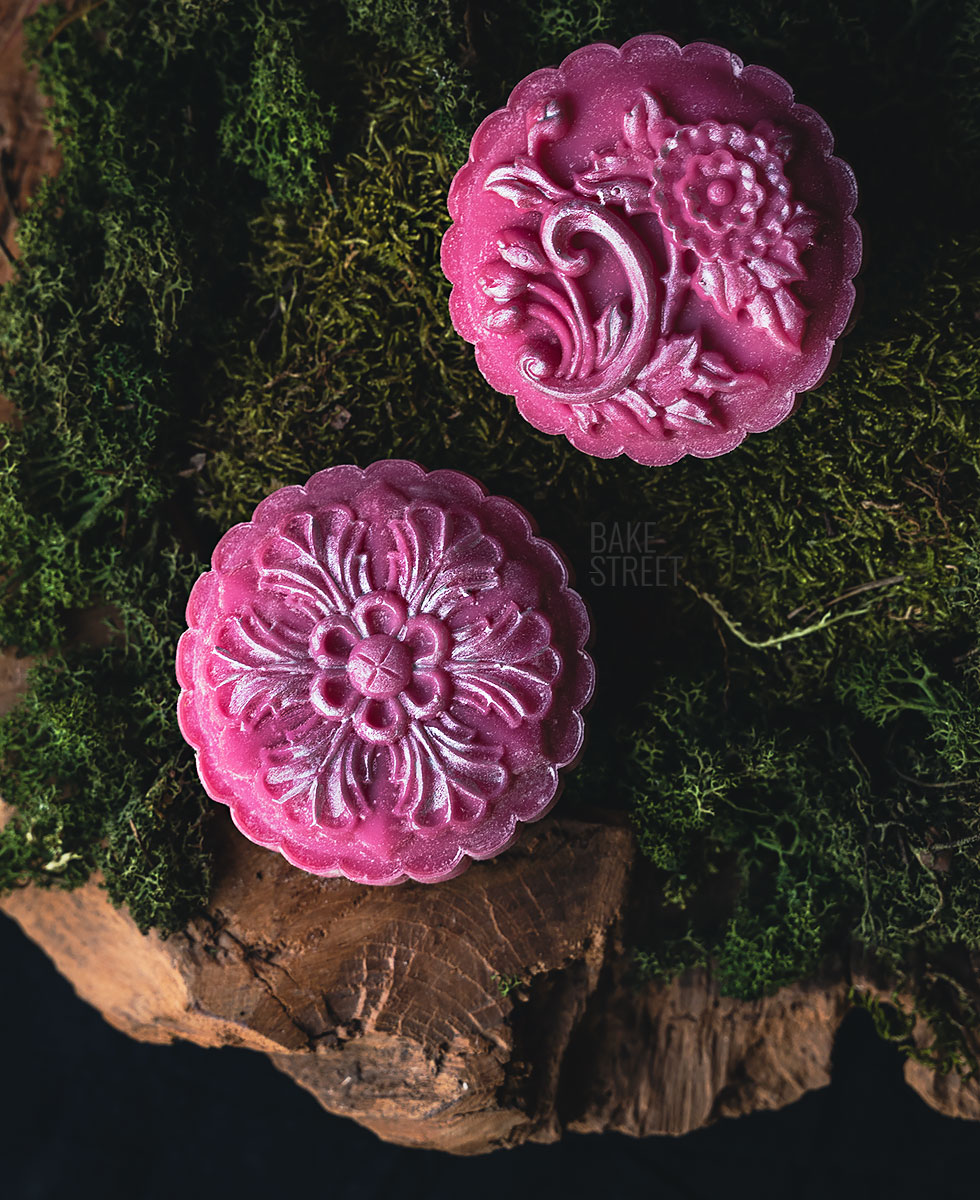
Making Snow Skin Mooncakes.
To prepare these cakes we need several ingredients among which, two of them, we cannot substitute for any other; rice flour and glutinous rice flour.
What is glutinous rice flour?
Glutinous rice flour is made from glutinous rice, which is also known as sticky, waxy or sweet rice. This variety of rice is grown mainly in Southeast and East Asia, including regions such as Bhutan and northeast India.
It is characterized by very little amylase and a high amount of amylopectin, which gives it its characteristic sticky quality. This sticky trait is essential in glutinous rice and gives it a sweet taste.
Mochiko flour is also a variety of glutinous rice flour, but it is made differently.
Mochiko flour.
Or Mochigomeko is prepared from short grain glutinous rice, known as mochigome, which is a variety of japonica rice. It is mainly used in the preparation of desserts, ice cream, rice pudding, rice cakes and the famous mochis, among others.
The main difference between these two flours lies in their production process: glutinous rice flour is obtained by grinding whole grains of glutinous rice to a fine powder, while mochiko flour is made by soaking glutinous rice in water until it breaks down into a sticky paste, which is then dried and milled to obtain a slightly coarser, granular texture powder.
Are rice flour and glutinous rice flour the same?
No, both flours are different and do not behave in the same way when we work with them.
Glutinous rice flour is produced from sticky or glutinous rice and is used in dishes such as mochi and dumplings due to its sticky nature. On the other hand, regular rice flour is obtained from any type of rice and is commonly used for baked goods or as a thickener in soups and sauces.
It is important to differentiate between these two varieties of flour and not to substitute them for any other.
On the other hand, we will use corn starch. This can be replaced by another variety of starch, whether potato, tapioca or even wheat. If we use the latter, the result will be good, but we will no longer have a gluten-free product.
The rest of the ingredients are very easy to access. The outer coating can be colored or left white. You can also use natural ingredients such as matcha tea, beet powder, cocoa powder…. Or even make them in various colors. We will leave this for another time 🙂
The process is very simple, mix ingredients, cook for a few minutes (steamed or microwaved) and knead. Once the resting time has elapsed so that the dough cools and acquires the right consistency, shape the mooncakes and that’s it. Ideally, we should let Sakura An Snow Skin Mooncakes rest in the refrigerator for about 3 hours before eating them.
Recipe Sakura An Snow Skin Mooncakes
Ingredients for 4 mooncakes, very large (2 pieces of 150 g and 2 pieces of 125 g)
SNOW SKIN MOONCAKES:
- 40 g glutinous rice flour
- 40 g rice flour
- 30 g cornstarch
- 140 g whole milk
- 50 g powdered sugar
- 20 g condensed milk
- 30 g sunflower or seed oil
- pinch of salt
- pinch of pink food coloring paste, I used Sugarflair "Claret" color
FILLING AND COATING:
- 310 g Sakura An, sweet bean paste with pickled cherry blossom (go to recipe)
- cooked glutinous rice flour ( following I show you how to make it)
MATERIAL WE WILL NEED AND SHOWN IN THE VIDEO:
- bowls
- silicone spatula
- digital kitchen scale
- small rolling pin
- steamer, I used my pressure cooker* (optional)
- Nordic Ware Naturals tray*
- scraper*
- pastry brush*
- large frying pan, mine is a De Buyer 28 cm diameter pan* (optional)
- lotus flower mooncake mold, 125 g
- round mooncake mold with four designs, 150 g
*In these products you have a 5% discount on the website Claudia&Julia using this code BAKESTREET. Delivers throughout Europe.
Instructions
FIRST DAY
Prepare "snow skin" dough for mooncakes.
- In a bowl add all the ingredients and mix with the help of a silicone spatula until homogenized.
- Once we have a uniform mixture, pass it through a strainer to remove and break up any lumps that may have formed. We will obtain a very smooth and silky mixture.
- Pour the mixture into a container that can tolerate steaming or one suitable for use in the microwave. Cover the container with film and perforate the surface.
- We can cook the mixture in two ways; place the pot on medium low heat and steam (in my case I used the fast cooker with the steam tray) for 20-30 minutes. Or in the microwave, at maximum temperature for 4-8 minutes.
- We will know that the mixture is ready when in the central part there is no liquid left.
- In the case of the steamer we will check how it is after 20 minutes and, from here, we will control it. In the case of the microwave we will do it in batches and we will check its state after 4 minutes.
- Remove from the steamer or microwave and mix with the help of a silicone spatula.
- Let it warm for a few minutes, just enough to be able to handle it with your hands, and knead.
- We must knead very well to achieve a soft, smooth, homogeneous and elastic dough. Be patient to achieve this result. The better it is kneaded, the less sticky it will be.
- Once the dough is ready, flatten, wrap well in plastic wrap and refrigerate, preferably for 12-24 hours.
SECOND DAY
Cook the glutinous rice flour.
- In a large skillet, add glutinous rice flour and cook over medium heat for 5-7 minutes, stirring constantly.
- Remove from heat, pour into a bowl and let cool completely.
Divide the dough to shape mooncakes.
- To shape this type of mooncakes, we will need the same amount of dough as filling. This step must be adjusted to your molds. In my case I used very large molds. I divided the dough into 2 parts of 75 g and the other 2 were 62.5 g.
- Place the scraps in the central part of the piece, bring the ends of it to the center and roll it between both hands. We will get a smooth, soft and shiny piece.
- Roll the piece in cooked glutinous rice flour, remove the excess and place on a tray.
- Repeat the same process with the rest of the pieces.
- Once they are shaped, cover with film to prevent them from drying out while we prepare the filling.
Shape filling pieces.
- For these mooncakes I used Sakura An paste, you have how to make it in this post.
We will form 4 pieces, two of them of 75 g and the other two of 62,5 g. We can round to 63 g without problem. - To be able to shape them without sticking to our hands, cover the palms of your hands with cooked glutinous rice flour and then proceed to roll each piece.
Shape Snow Skin Mooncakes.
- With the help of a rolling pin, stretch a piece of pink rice dough. We must give a larger diameter to the piece of filling, enough to cover it, but without overdoing it or else we will have dough left over in the sealing part.
- Place the filling piece on the stretched dough and adjust carefully. Begin to join the base until it is completely sealed. Gently roll and cover with film.
- Repeat the same process with the rest of the pieces.
Create the pattern with the mold.
- Roll a piece over a bowl with cooked glutinous rice flour, remove the excess.
- Place the mooncake mold over the piece and press down hard 2-3 times. Remove the mooncake from the mold, pressing down in the same way as if we were going to mark the cake and place it on the tray.
- Repeat the same process with the rest of the pieces.

Decorate, if desired.
- Before painting or serving the mooncake, if not painted, we must remove the excess rice flour. To do this we will use a pastry brush.
- Dissolve silver coloring powder in half a teaspoon of vodka or gin. Stir very well so that both elements are integrated.
- With the help of a pastry brush, paint the highest parts of the mooncake with the silver mixture. We should not make too much effort, just give details. We must also be careful not to overpaint the surface with too much liquid, the brush always well drained.
- Serve after a minimum of 3 hours in the refrigerator.
- NOTE: These mooncakes should ideally be eaten the same day they are made. They can be kept refrigerated in an airtight container in the refrigerator for 2-3 days. After this time, the outer coating will start to dry out and they will not be as good.

Notes
- Neither glutinous rice flour nor rice flour can be substituted for any other variety. Both must be used for optimum results.
- Corn starch, Maizena, can be substituted for another variety of starch if you wish; potato, tapioca....
- When we cook the dough, either steamed or in the microwave, it is completely normal for it to have a greasy appearance. We will have to knead very well to integrate all the ingredients and achieve a smooth and silky finish.
- It is not mandatory to color the dough, we can make them white if we wish.
- The filling we use for this type of cake must be moldable and not contain too much moisture. Otherwise it would spoil the final result. We can use anko or lian rong, for example.

- To cover both the outer dough and the filling, and to be able to handle it, we must use glutinous rice flour previously cooked or toasted, not raw.
- It is very important to roll the piece in cooked glutinous rice flour to shape it with the mold, otherwise there is a high risk that the dough will stick to the mold. To remove the excess we will use a pastry brush.
- To make these mooncakes I used two molds, a lotus flower mooncake mold, 125 g and a round mooncake mold with four designs, 150 g.
- It is very important to weigh both the dough and the filling. The combined weight of both cannot exceed the amount of dough your pan can tolerate. The amount of filling and dough, for this variety, should be the same.
- They can be stored, refrigerated, in an airtight container and without stacking the pieces for up to 72 hours. After this time, the outside will begin to dry out and change from a tender texture to a hard, dry one. They can also be frozen, placed in a single layer in an airtight container. Once completely frozen, they can be individually wrapped or stored in airtight bags for up to 1 month.
- If we use fresh fruit inside the mooncake, I do not recommend freezing it. The fruit changes its texture and it is common for it to release water, which would spoil the final result of the product.

If you are as fond of Chinese gastronomy as I am and you like to elaborate this kind of recipes, so different and original, do not miss to try these Sakura An Snow Skin Mooncakes.
In this case, we could consider it a fusion of Chinese and Japanese cuisine, since the filling I have used this time is a bean paste with pickled cherry blossom.
It is a slightly sweet, aromatic and floral cake, with a soft, tender and silky texture. A different way to enjoy these small bites.
I wish you a wonderful Sunday, lots of love!
Eva
Sources: Cakere, Nuevo Plasencia
This post contains affiliated links.
